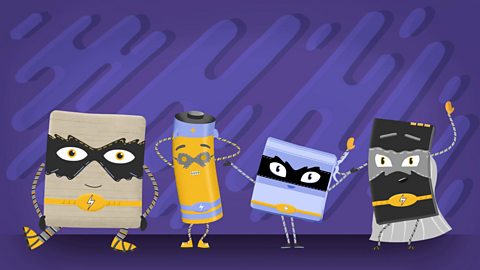What are sustainable textiles?
Textiles are all the different types of cloth or fabric that we use. They can make clothes, furnishing and even buildings.
Different textiles can keep us warm and dry and let us express ourselves with different designs and styles.
In this article you can learn about:
- Natural and synthetic textiles
- The impact textiles have on the environment
- How we can reduce the impact of textiles on the environment
- The advantages and challenges of textiles
This resource is suitable for Sustainability topics for primary school learners.
Video - Textiles and sustainability
In this video, learn about different materials and how we can reduce the impact of textiles on the environment.
Meet Textiles - Tex for short - and his pal Woolly.
Tex is made of loads of types of fabric; like cotton, polyester and, yes, wool.
We use these materials to keep ourselves warm, to protect us in emergencies and to express ourselves.
Very stylish, Woolly!
Before the 1900s, the only clothes we produced were natural, made out of plants and animals.
And now we also make synthetic textiles out of fossil fuels like oil.
Not like that, Woolly!
Oil is used to make fabrics like polyester, acrylic and spandex which are all types of plastic.
And like all plastics, they take hundreds of years to decompose.
But itâs not just synthetic textiles that damage the environment.
Natural ones can too.
Making a simple pair of jeans can use up to 10,000 litres of water!
This starts in the fields of warm countries, where lots of water is needed to help cotton plants grow.
After the cotton is picked and processed, itâs dyed.
Dyeing cotton also uses a lot of water, and the waste run-off can pollute local rivers.
And even after theyâve been made, jeans are still thirsty because youâve got to wash them when theyâre dirty!
It doesnât stop there either. Ever heard of âfast fashionâ?
Impressive, Woolly! But no, not that kind of fast fashion.
Lots of clothes made with synthetic fibres are produced quickly, and sold at ultra-low prices, only to be worn a few times, and thrown away.
The fashion industry actually produces 10% of global carbon dioxide emissions, which speeds up global heating.
So, what can we do about it?
Well, we can reduce waste by not buying as many clothes.
By repairing our favourite clothes.
By swapping unwanted stuff with friends or donating to a second-hand shop.
Or by turning our old clothes into something completely new. Like a bag.
The thing is, there will always be some amount of waste and pollution when Tex is around.
But as long as he keeps us warm, dry and cool, weâll keep searching for ways to lessen his impact on the environment.
What are natural and synthetic textiles?
Before the 19th Century, all textiles were made from natural materials such as:
- animal products (for example leather, wool, fur and even silk)
- fibres from plants (for example cotton from cotton plants or linen from a plant called flax)

Image caption, A long time ago, people would dress themselves using natural materials. Lots of us wear natural textiles like cotton, linen and wool today. Some people, such as the Inuit people of Canada still use animal furs for clothing and accessories. (ton koene / Alamy Stock Photo)
Image caption, Cotton has been used by people for thousands of years. It is not only used to make clothing, but can be used to make many other things like bedding, curtains, towels, bags, shoelaces and more. (David R. Frazier Photolibrary, Inc. / Alamy Stock Photo)
Image caption, Instead of coming from plants or animals, synthetic textiles are made from fossil fuels, mostly oil. (Jim West / Alamy Stock Photo)
1 of 3
In the 19th Century, new ways were found to turn natural materials into textiles like rayon. This meant that much more could be produced in factories.
In the 20th Century, different syntheticNot found in nature. Man-made. textiles were invented, for example nylon, polyester, acrylic and spandex. These are all made from different types of plastic. Instead of coming from plants or animals, these textiles are all made from fossil fuels, mostly oil.
Making clothes out of these synthetic textiles can have advantages and disadvantages:
- Polyester dries more quickly than cotton and is easier to dye or colour but can become smelly because bacteria grow well on polyester fibres.
- Acrylic is soft and warm like wool but cheaper to make. However it can cause static electricity to build up and is very flammable.
- Nylon is thin, strong and water resistant but it shrinks when it gets too hot.
- Spandex is stretchy and can make aerodynamicsThis describes how air moves around an object. An aerodynamic object is often described as streamlined. clothes for athletes. It isn't breathable, so it has to be combined with other materials to stop you getting sweaty.
All of these synthetic fibres have environmental disadvantages.

The impact textiles have on the environment
Synthetic fibres
All synthetic fibres have environmental disadvantages. They all use lots of energy to produce and making them can cause pollution. In fact, 10% of global carbon dioxide emissions are linked to fashion and textiles. They are still mostly plastics, so they don't biodegradeTo break down and disappear over time. and even washing them releases tiny pieces of plastic into the water system.
Fast fashion
Lots of clothes made using synthetic fibres are âfast fashionâ, which means they are made very cheaply, sold at low prices and designed to be worn and look good for a few times before being thrown away. This is a huge waste of energy and material and takes up space as landfill.

Image caption, Fast fashion creates cheap clothing that is often thrown away after being used for a short time. They are normally made from synthetic textiles so don't biodegrade and end up in landfill waste. (Anneliese Gruenwald-Maerkl / Alamy Stock Photo)
Image caption, To protect crops like cotton or flax from pests, farmers spray chemical pesticides. These are not good for the environment or human health. (clynt Garnham Agriculture / Alamy Stock Photo)
Image caption, Although your clothing may have been made in one country, the likelihood is that your item of clothing has been on a longer journey. The more miles your clothes have travelled from âfield to clothes rackâ the more damage is done to the environment. (luciopix / Alamy Stock Photo)
1 of 3
Plant fibres
Natural materials like cotton also have a harmful impact on the environment. A lot of water is needed to grow huge numbers of cotton plants needed to meet the world demand for jeans, t-shirts and other cotton clothing.
Making a pair of jeans can use 3,781 litres of water while growing the crops and dyeing the jeans. There are also many bugs and pests that harm cotton plants. So, to tackle that problem, many farmers around the world use chemical pesticidesChemicals used to kill pests., which can damage the environment or human health.
Animal products
Some people think that it is wrong to farm animals for textiles and materials.
We need to think about the impact from materials from animals too. Keeping sheep for wool or cows for leather all takes up land and energy. Unless they only eat grass, then more land and energy is needed to grow and deliver food for them. Cows produce a lot of methane which is a greenhouse gas that contributes to global warming.
All textiles have an environmental impact. One of the best ways to reduce this is to use less.
What is the journey of a t-shirt?
If you look at the label on one of your t-shirts it will tell you where it has been made. However, this is only part of the story.
In order to make your t-shirt it will have gone on a journey from field to clothes rack. The clothes miles are not just from the place the clothing was made to the place it was bought.
It may have started its journey as a cotton plant grown in India, then sent to China where the raw cotton is made in to material. The material may then be sent to Bangladesh to be made in to a t-shirt, before travelling to the UK where it will be bought.
That may not be the end of the journey, as some people choose to recycle their old t-shirts, they can be sent to developing countries for other people to wear.
How we can reduce the impact of textiles on the environment
To reduce our negative impact on the environment through our clothing choices, we can follow the simple rule of Reduce, Reuse, Recycle. We can:
- Reduce the amount of clothes we buy and avoid fast fashion
- Buy clothes that have been made more locally and that have used less energy and transport to get to you
- Mend clothes we have so we donât have to buy lots of new clothes
- Reuse clothes by repurposing old clothes for new things. Lots of talented and creative people will use the old material from their clothes to make new clothes or other items like bags
- Swap clothes with friends
- Donate your unwanted clothes to charity shops so other people can reuse them
- When finished with the material from our clothes, we should recycle them. Most large supermarkets have clothes recycling points which are easy to use and make sure that material doesnât go to waste
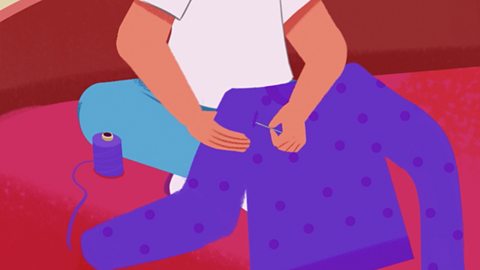
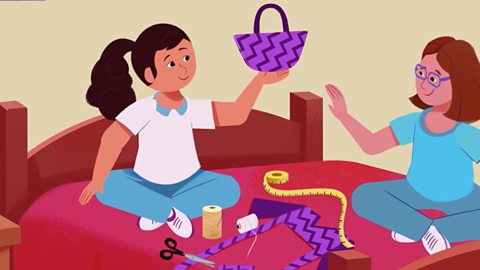
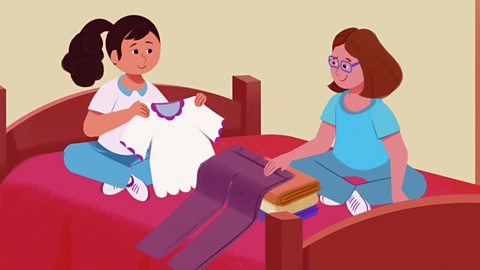
What are the advantages and challenges of textiles?
Advantages
Having a choice of natural and synthetic materials for clothes means we can choose the way we want to look and express ourselves through our clothing.
Synthetic materials have allowed us to design clothes that better meet our needs. For example, better clothes for sport and for lightweight but warm clothes in colder climates.
Many types of materials can be recycled into new clothes, furnishings or other products.
Designers have now developed the ability to create recycled clothes from recycled cups and plastic.
By taking your clothes to a clothes bank or a charity shop, you will be helping other people. Not only will other people be able to wear your unwanted clothes, but you will also be helping raise money for a good cause.
Challenges
Cotton is used to make many different things, but in order to grow cotton harmful chemicals are used that pollute the local environment.
Jeans are made from cotton and 3, 781 litres of water are used to make just one pair of jeans.
We should be aware of how far all our clothes have travelled to get to us. The further they have to travel by boat, plane or road, the worse the impact on the environment.
Synthetic materials are made from fossil fuels which are harmful to the environment. Producing them uses lots of energy and water, and can cause pollution.
Synthetic materials do not biodegrade which means we have to find other ways to dispose of them.
Our clothes are often made in developing countries where working conditions for local people are poor. The amount of money they are also paid can be extremely low.

Key words about different materials
Sorry, something went wrongCheck your connection, refresh the page and try again. - Artificial materials that cannot be found in nature. Things like plastic, that can be created by combining different chemicals, can be used to make materials such as polyester, acrylic and spandex that are used to make clothing.
Sorry, something went wrongCheck your connection, refresh the page and try again. - Materials that are found in nature and have not been made by humans.
Sorry, something went wrongCheck your connection, refresh the page and try again. - Coal, oil and gas are the three fossil fuels â these are our non-renewable energy sources. They are called fossil fuels because they are made from dead animals and plants. These animals and plants are compressed underground over millions of years and they eventually turn into fossil fuels.
Sorry, something went wrongCheck your connection, refresh the page and try again. - Natural resources that cannot be replaced after they are used are non-renewable. This means that they exist in a fixed amount on Earth. Fossil fuels such as coal, oil and gas are all non-renewable resources.
Sorry, something went wrongCheck your connection, refresh the page and try again. â The study of how air moves around a solid object. Cars and planes are designed to be aerodynamic, meaning air can pass over them so they can move quickly.
Sorry, something went wrongCheck your connection, refresh the page and try again. - The long-term change in weather patterns (temperature, wind, rainfall etc.) on Earth, including its side-effects, for example increased drought and flooding.
Sorry, something went wrongCheck your connection, refresh the page and try again. - The release of carbon into the Earthâs atmosphere, which contributes to climate change.
Sorry, something went wrongCheck your connection, refresh the page and try again. - The ability of a material to break down and disappear over time. Some materials are dissolved by bacteria or other biological elements. If a material is biodegradable, it means that it can be consumed by microorganisms. It is an important process in ecology and waste management.
Test your knowledge
Quiz
Challenge

Donate or mend clothing
Find out where your nearest clothes bank and charity shop are. The next time you have a clear-out of clothes that are still in good condition but that you no longer want, take them to the clothes bank or charity shop instead of binning them.
If you are going to throw out a piece of clothing that has a hole, rip or other damage to it, try to learn how to fix it instead. Ask a family member if they can help you to mend the clothes or together you might be able to learn using a video on the internet.
More on Sustainability
Find out more by working through a topic
- count12 of 28

- count13 of 28
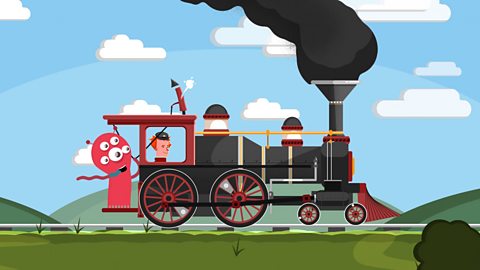
- count14 of 28
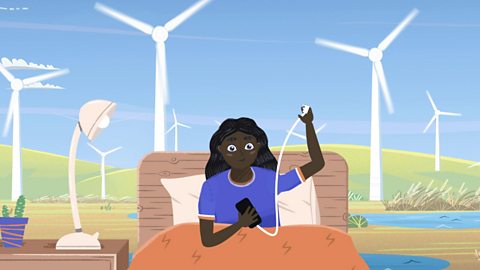
- count15 of 28
